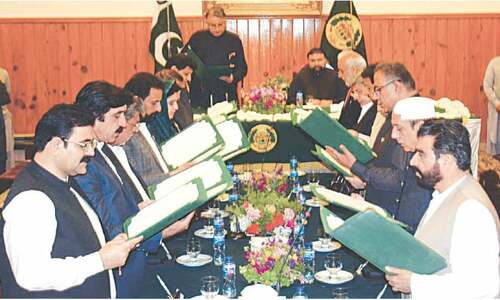THE study of poetic metres is called prosody. Prosody is known as arooz or ilm-i-arooz, not only in Urdu but in Arabic and Persian as well.
Other prosodic terms such as behr (metre), rukn (feet of a metre), taqt’ee (scansion), qaafiya (rhyme proper), radeef (recurring words at the end), mutahrrik (movent), saakin (quiescent), zihaaf (catalexis), and daira (circle), too, are borrowed from Arabic by Urdu. Prosodic issues in Urdu are discussed in exactly the same words.
The reason is that prosodic knowledge was borrowed from Arabic by Persian and Urdu and terminology was taken verbatim. Khalil Ibn-i-Ahmed, an Arab linguist and lexicographer, had formulated the rules dealing with arooz or prosody in the 8th century AD. Later on, Akhfash, an Arab grammarian, expanded those rules. A vast body of works dealing with prosody and related issues exists in Arabic and Persian and they inevitably influenced Urdu, as Urdu borrowed all the rules as well as terms.
In Arabic, there are 19 metres, but in Urdu mostly 12 or 13 are used though some of Urdu poets intentionally compose poetry in less-used metre, too, to prove their mastery over prosody. Some scholars believe that many poets have a special knack for some specific metres as their inner rhythm dictates the patterns of sounds in their verses. But these 19 metres, or 13, as the case may be, are the basic forms and their variant forms with some changes may be numbered in hundreds, or even more. Such changes --- which may occur in the feet of the verses --- are called zihafaat, or catalexis, and they allow replacing certain syllables in a poetic line with longer or shorter syllables.
Interestingly, Arabic prosody favours specific metres for specific poetic genres, since metres have some sound patterns, tempo and flow that suit certain moods and topics. For instance, battle songs were composed in behr-i-rajaz as its rhythm supports the martial themes. Similarly, behr-i-hazaj is considered more suited for soft and sweet verses because of its modulations. This idea entwined with the inner rhythmic patterns of a poet determines the metre of a specific verse composed by a specific poet. For example, in Ahmed Faraz’s poetry, we find a metre named behr-i-ramal musamman makhboon maqsoor-o-mehzoof repeatedly used and almost thirty per cent of Faraz’s ghazals are in this metre. Faiz Ahmed Faiz often used behr-i-mujtis. Ramal and hazaj are Iqbal’s favourite metres.
Another interesting aspect of Urdu prosody is that some poets of Urdu were deeply influenced with the ancient Sanskrit prosody that was used in Hindi poetry and differed from Arabic prosody. Pingal or pingala, as Sanskrit prosody is known in Hindi and Urdu, exerted much of its influence on Mir Taqi Mir, one of the greatest poets of Urdu. Many of Mir’s verses are in a peculiarly different metre though Urdu or Arabic’s traditional prosody can explain this use in its own way as some of Arabic metres with changed syllables allow the use of such feet (rukn). Shamsur Rahman Farooqi has discussed this special metre used by Mir and called it ‘Behr-i-Mir’. Majeed Amjad composed most of his poetry during his last years of life in this very metre, called ‘Behr-i-Mir’. Ibn-i-Insha, a humorist who was a fine poet too, was much impressed with Mir and followed in his footsteps both in style and prosody. The reason? Firstly, the inner rhythmic pattern that suits a poet and, secondly, it sounds more harmonious.
Gopi Chand Narang in his research work has drawn, on the basis of linguistics and phonetics, some interesting conclusions from the metres used by Urdu’s poets. He says, for example, the more syllables with long vowels a verse has the more melodious and euphonious it sounds. Mir’s poetry is more pleasant-sounding because it has syllables with more vowels or long vowels. Same is true for Iqbal’s poetry, says Narang. But Ghalib’s poetry is not as sweet-sounding --- and this comparison is limited to sounds alone --- as it has more words with less vowel sounds. This invariably draws one’s attention to the fact that Mir has used more local (read: Urdu/Hindi) words than Ghalib and these local words have syllables with long vowels or more vowels, whereas many Arabic words, and some Persian words, too, have fewer vowels as these words often have consonantal clusters. Consonantal clusters are two or more consonants without vowels in between, hence difficult to pronounce, such as, qatl, sabr, hukm, zakhm, etc. that have consonantal clusters at the end. Less educated people usually put a vowel between the last two consonants in such words to make them easy to pronounce and say qatal, sabar, hukam, zakham, etc. instead.
This brings up another important aspect of prosody: it helps improve pronunciation as incorrect pronunciation would render verses out of metre.
So, prosody is a useful and all-important skill and new generation must learn it.
Published in Dawn, April 4th, 2022












































Dear visitor, the comments section is undergoing an overhaul and will return soon.